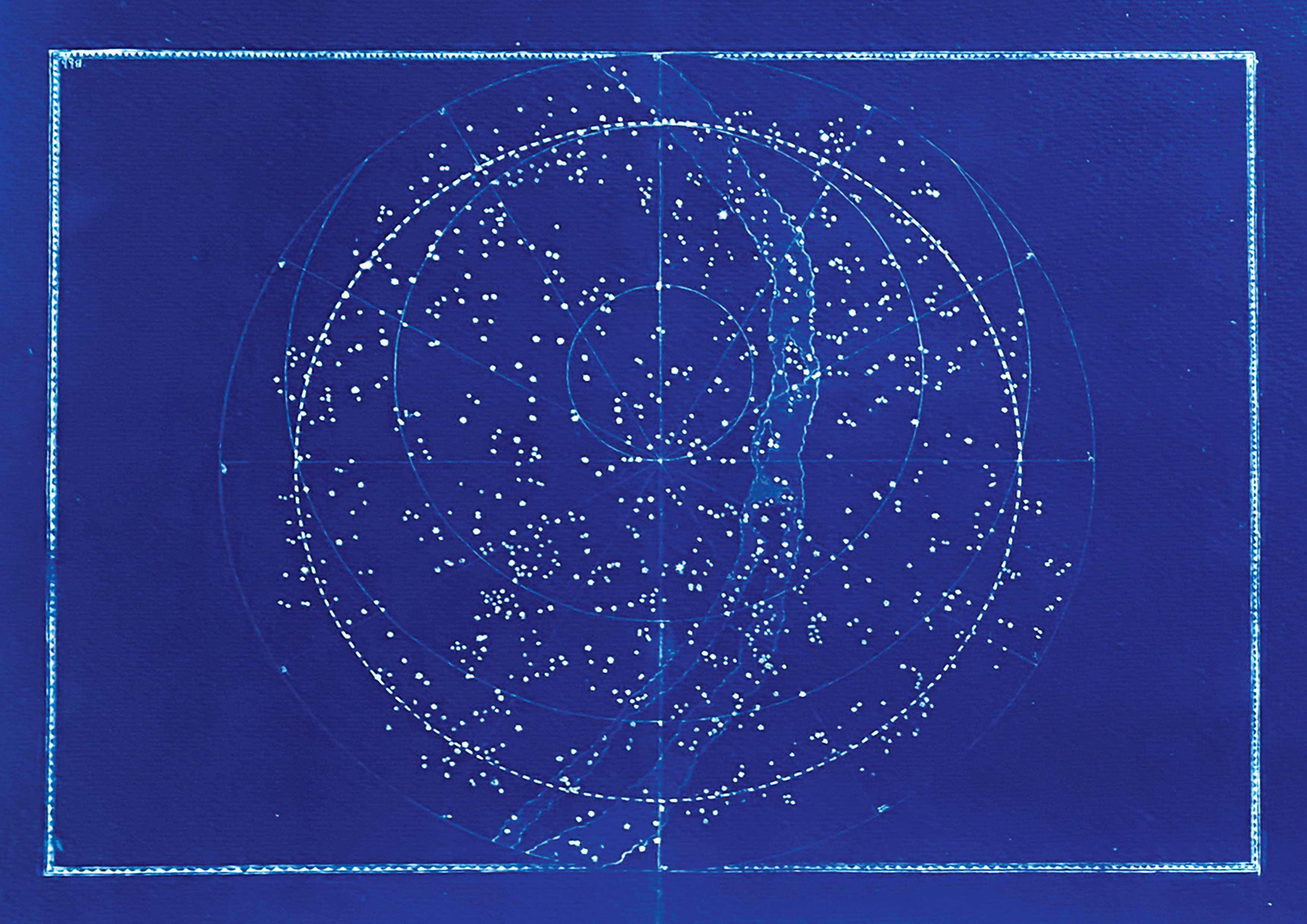
‘Countless crossings, fatal shores, remote ghost trees on both sides; faithful wives, metaphors with no memories, the cosmos
Colourless smells, this journey from the ocean to the Himalayas
Padma and Jamuna’s water and sand, selfsatisfied, dissatisfied release
Lolling on the makeshift cot, the moon calls, Come, today I am
the earth’s twin sister, a frozen flood tide of flesh and blood’
––At Aricha Ghat, Mohammad Rafiq (2012); Translated from Bangla by Carolyn B. Brown
Moreover, the traumatic experience for the whole family exceeded the horror of the entire cataclysmic event outside. Bangladesh experienced its most severe and enduring flooding of the century between July and September of this year. The disaster impacted around one million households, causing extensive damage and displacements. Approximately 30 million people from 6 million families were affected due to the loss of primary crops, including rice. The floods affected 51 districts of 64, including the capital city of Dhaka, making this year the most catastrophic in collective memory. In our village, all houses and roads were swept underwater; I was swimming and fishing on the submerged street underwater with other kids.
From a subjective experience, this was my first encounter with ‘Hydrotrauma’ that led to a complex troop of thoughts about how, as a living body, water shapes, moulds and transforms life in the Bengal basin, particularly in the Brahmaputra delta, which is the most endangered hydrological terrain in the global south.
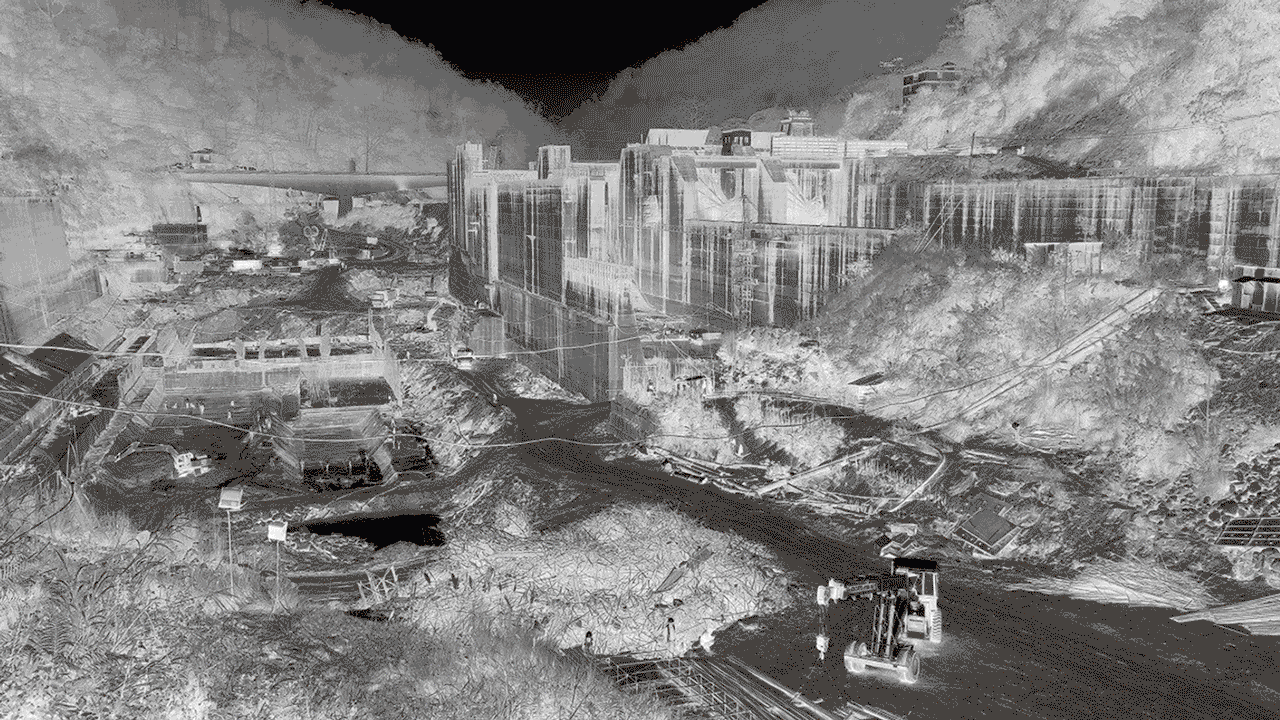
Hydrotrauma
Hydrotrama, or ‘the psycho-physical hazard’ in the deltaic watery landscape in Bengal, originates from the numerous onto-epistemological (Barad 2007) violence existing within the constructed concept of ‘River’ ecology. The legislation systems by colonial officials of the 18th century that created property and taxation and still working as a repressive tool.
‘Hydrotrauma’ is an accumulated result of colonial legacies in determining the deltaic landscape: anthropogenic infrastructures created for human- centric economic and political gain in the wetlands; several hundred years of neglecting indigenous practices, rights, and traditionally accustomed relationship with the most vulnerable and catastrophe prone hydrological terrain. Concurrent highspeed arctic icecap melting throughout the last century contributes to the climate emergency and anthropocentric collapse conundrum. The perception of rivers is influenced by settler-colonialism, leading to water being seen primarily as a resource. Indigenous ideas are usually removed from their local context and disregarded. Water becomes a manageable entity for human use and legal governance for its property value. The separation between water’s socio-political and cultural aspects is contested by many.

Teesta river basin/ Char in the dry season, when the dams are closed. Source: DW বাংলা
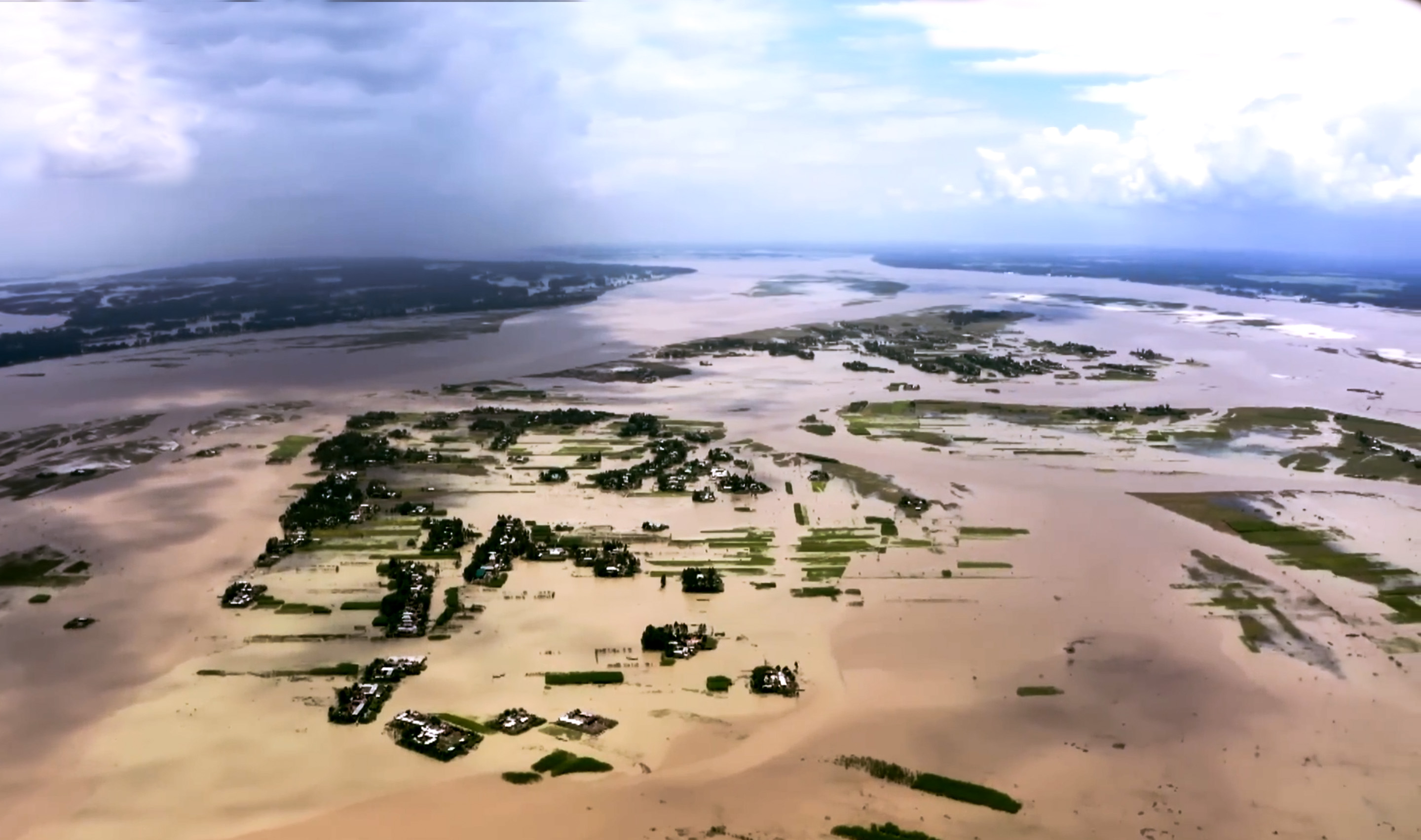
Teesta river basin/ Char in the monsoon, when the dam gates are open. Source: DW বাংল
Indigenous
Hydroontologies
‘We don’t think there is a river here. All these floods are like a blessing for us. Because the more often the flood comes, the better it is for our farming, the more we can grow. All this is just a river when the monsoons come. When it’s over, this is our farmland. These fields only lie unplanted for two or three months, just when they are flooded. Only during this time, we cannot cultivate. Then, everything is a river. That’s why I think we live in the river, but it doesn’t feel like it. And our soil here has a big advantage: we don’t necessarily always need water for the plants. Sometimes, you just see sand. For example, here, this soil. There, see how the peanuts are thriving. But you can see how dry the soil is!’
–– Rahim, An elder farmer in the Teesta basin
Colonial Epistemologies in an Engineered Landscape: An intergenerational trauma
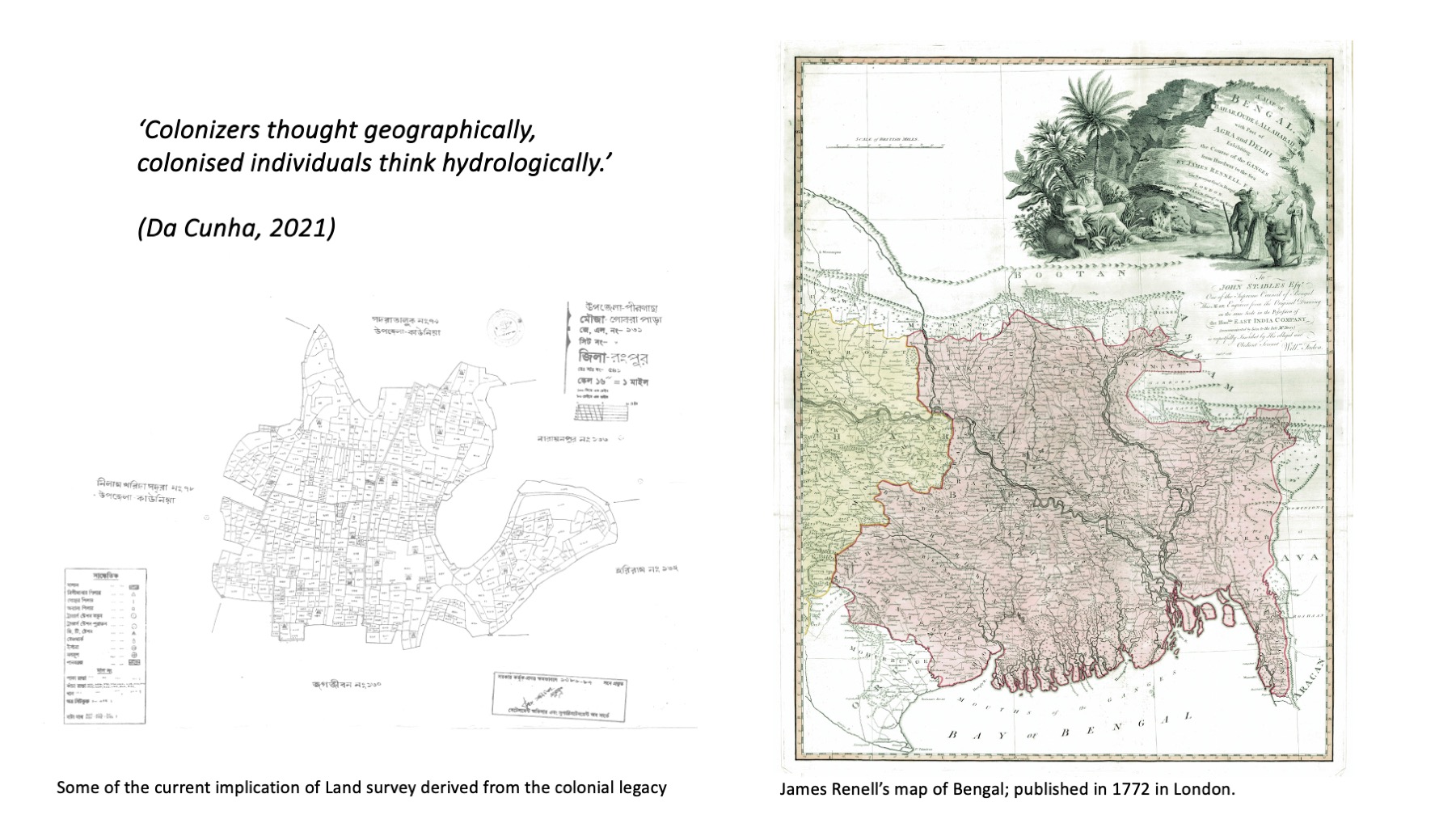
Governments and engineers prioritise instrumental approaches for revenue generation and quantifiable benefits through dams and barrages falsely manifest irrigation and agricultural purposes, But in the reality, the planned waterscape has accelerated flooding and erosion in the Bengal Delta due to the implication of hydropower control policies, ignoring its inherent natural mobility. In 1901, British historian C.R. Wilson observed that the capricious Nature of Indian rivers moulded Bengal's landscape. Similarly, in 1923, colonial geologist James Ferguson lamented the perpetual flux of the land in a lecture at Calcutta University, underscoring the oversight of seasonal dynamics in the deltaic ecology.
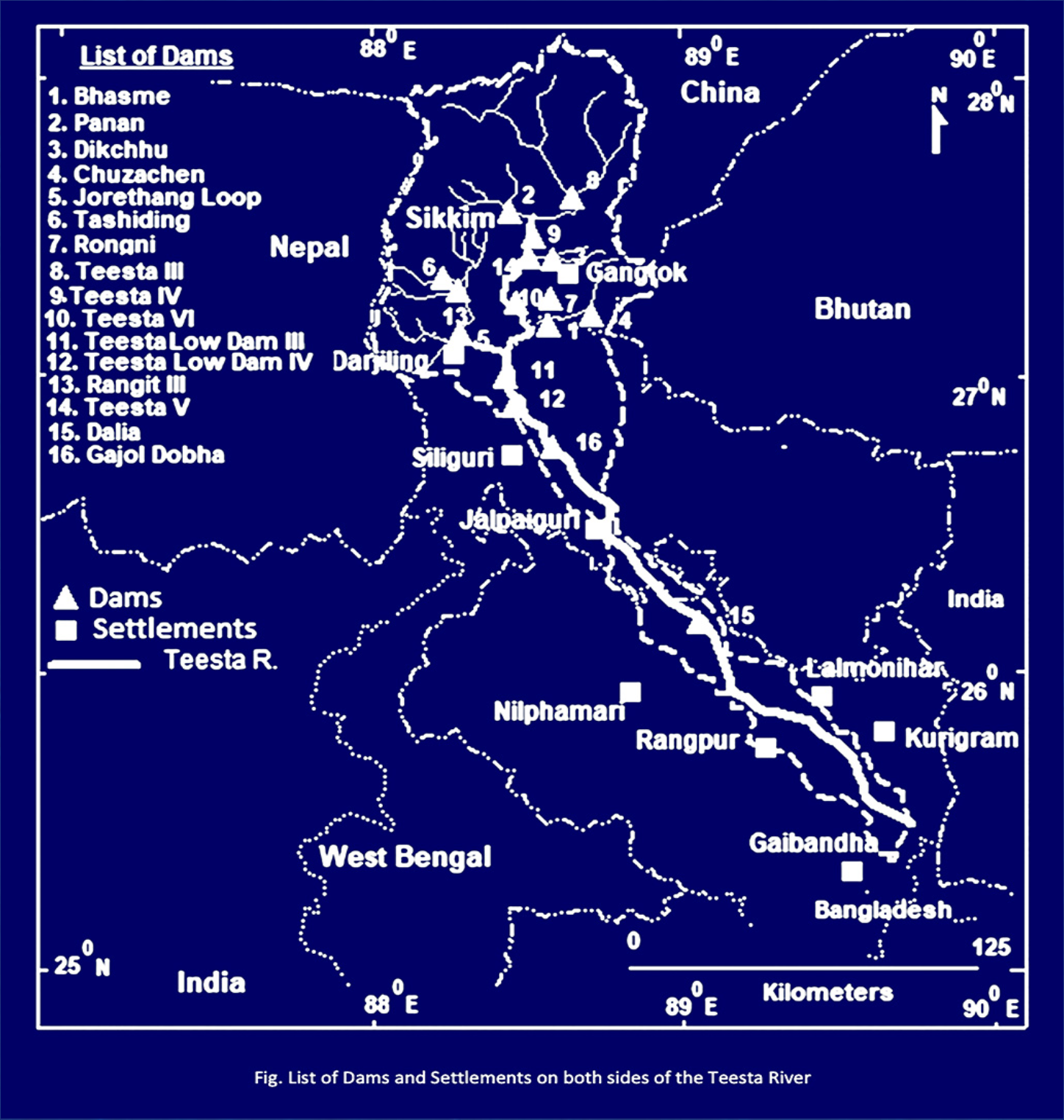
“Without lines, rivers are inconceivable, which is to say that, to hear or speak the word ‘river’ is to think the flow and see lines.”
(Da Cunha, 2018)
Difference between neighbouring nations' interests—hydroelectricity for India, irrigation for Pakistani middle regions, and fishing communities' focus on water and fish—poses a challenge. Including fishing communities and considering their voices as ecological units is vital to ensure balanced decision-making. The language used in framing river-related problems determines the discourse's trajectory. Engineering perspectives should not overshadow the importance of ecosystems and spiritual agencies of indigenous communities.
People have had a co-dependent relationship with non-human life forms in the Bengal delta region for thousands of years. Indigenous river communities in Bangladesh endure the challenges of life and livelihood amidst the unpredictable patterns of accretion and erosion on the ‘Chars’ while maintaining a symbiotic relationship with Nature.

Human, non-human, more than human entanglements in the Teesta char; Source: DW বাংলা
Char: A more-than-human kin in a creolised body
Chars are part of the ecology of floodplains, an ecological common belonging to ‘Chauras’ or ‘the floating gipsies.’ 'Char' can be translated as wonder, coming from the 'Although of Bengali ethnicity, Chauras came from diverse lineages and occupied many different communities within the villages on the chars. They were neither entirely homogeneous nor quite as motley as mainlanders made them out to be, as will become evident over the course of this book. I decided to use the term chauras interchangeably with char dwellers to indicate this population whose backgrounds and behaviour were within a given range of variation, as well as to indicate an existence that carried the sting of mainstream judgment... Chauras lived in a conditional mode, with many “if this, then that” scenarios crowding their daily life and future horizons. The issue of the interrelation between Chauras and variable temporal horizons takes on urgency in the era of global climate change.' (Khan, N. 2023, 2-3) 'Chauras', the wanderers. Chauras are less likely to migrate, but the land itself migrates here, and people wander along with the resettled land. The indigenous river communities, in this case, Chauras, have accepted the natural transformation of accretion- erosion-flood and life with its challenges and changes. They intermingle with their surroundings not by conquering Nature but by embracing it in various forms and dimensions. It is as if an all-encompassing creolisation is taking place in the Chars. 'Creolisation’ here refers to a shifting co-becoming: a culturally complex adaption process, pluri-legal riverine society existing and regenerating in this amphibian ground.
The relationship between creation and destruction with time in a life centred around Teesta's flashy water basin is reciprocal and unexpected. It is essential to note the ontological similarity of Nature and culture in the Chaura life. The connection between shifting landscapes, human, non-more than human and culture is more intimate here. Nature profoundly shapes Chaura lives by traversing individuals and local cultures, and, unlike other urban places, indigenous river life embodies Nature with heightened clarity. Although perceived as an external stimulus, In Chaura life, Nature is foundational in embodying human subjectivity and thoughts by establishing a connection between the body and mind, weather and water, air and earth.
Historically, anthropological scholarship emphasises the defence against Nature while confining it mainly to the physical environment, race/biology, and ecology/ ecosystems. This narrowed focus on human aspects excludes all non/more-than-human agencies from Nature. Unlike the policymakers who decides to reshape Nature according to abstract concepts like the nation-boarder-state policies, unaware of the actual impact on human existence while ostracising the indigenous legal policies, I see Nature as intrinsic and indifferent to human desires and will. therefore, reflecting back all the emotions and relations of the place into the indigenous legal policies that are governing the Nature are essential.
Embodied Experience of Hydrotrauma in Chars
The cultural amnesia in Char life arises from colonial epistemologies and hydropower policies, resulting in the dispossession of cultural memories among the Chaura community due to historical injustices and violence. "Ruptures" in Glissant's (1997) "Poetics of remembering" are comparable to collective memory disruptions caused by forced dislocation and disasters in Chars. D. Shushanto Bhattacharjee explains that Teesta River's inhabitants have changed their way of life due to the fluvial disruptions, resulting in a shift from river-based labour to urban-centred livelihoods, causing people to relocate from the periphery to the centre, Dhaka. The Bairali fish and the local fishing instrument made with Bamboo are no longer seen in Teesta.
Bhawaiya a genre of north Bengal folk song, believed to have originated in rangpur and Cooch Bihar, India. The name of this folk song, generally about love between man and woman, derives from bhava (emotion). Bhawaiya songs, however, may also be spiritual in theme as in 'fande pariya baga kande re' (The heron cries entrapped in a net), 'chhar re man bhaver khela' (O my mind, leave earthly games), etc. Source: Banglapedia.
‘Bhawaiya’ singer Kasimuddin's songs mentioning different forms of river songs and fish names are no longer relevant. There were more than 45 types of
Palagaan is a traditional Bengali folk theatre popular among rural areas. It is performed by a group of performers. The bayati (the lead narrator) leads a Palagaan troupe of five to eight choral singers (dohars). Pala gan originated in Mymensingh, with many of the ballads being based on real events. Charming descriptions and realistic portrayals of character are special features of these pala gan which use dialect and folk rhythms. A few of the composers whose names are known are mansur bayati (Dewana Madina), Fakir Faizu (Chhurat Jamal and Adhuya Sundari), Dvija Kanai, Chandravati, Dvija Ishan, and Sulagain. Their pala gan provide a detailed portrait of the society of their times. Many pala gan were collected by dinesh chandra sen and included in maimansingha gitika and purbabanga-gitika, published by Calcutta University. Source: Banglapedia.
‘Palagaan’ before, but now only two or three can be found. The ‘Bathan culture’ of tying and feeding Buffalos on the riverbanks has disappeared. Traditional celebrations such as ‘Teesta Buri Puja’ and ‘Mechen Buri Puja’, along with the loss of the popular river sport ‘Nouka Baich’, have resulted in the demise of the region's cultural materials and cherished memories. The novel
Kando Nadi Kando (Wail, River, Wail) is a novel by syed waliullah (1968). Though Waliullah is largely influenced by the western style of fictions, his characters, the landscape, and the social milieu in the Kando Nadi Kando are fundamentally Bengali. The story of the life of the junior magistrate, Muhammad Mustafa, of Kumurdanga, is narrated by a steamer passenger, Tabarak Bhuiyan.The tragic story of Muhammad Mustafa juxtaposes the picture of the common people of Kumurdanga, whose lives are influenced by the drying Bakal river.
‘কাঁদো নদী কাঁদো’ ‘Wail, River, Wail’ by Syed Waliullah exemplifies how the river's death leads to the region's death. The death of representation in culture, dislocation of body and consciousness also leads to what Glissant call ‘nonhistory' (1997).
For Stacy Alaimo (2012), human bodies are not insular entities, but rather, they are deeply interwoven within ecological, geological and climatic processes. The theory suggests that human bodies are interconnected with the wider physical and biological environment, constantly exchanging energy and matter. Trans corporeality highlights the permeability and porosity of the human body, examining how environmental issues are embodied within it. This includes analysing how the body assimilates pollutants, toxins, and environmental changes, potentially leading to health effects. Dr. Mubin Syed claims that British colonialism's famine continues to impact South Asians' physiology today. The Indian subcontinent faced as many as 31 severe famines under British rule, resulting in millions of deaths. Survivors passed down bodies adapted to starvation and the trauma experienced through epigenetics (Syed, 2022). Alaimo states how marginalised communities bear the brunt of ecological degradation due to power structures, colonial legacies and gender dynamics. The Chaura life carries Hydro trauma with all its aforementioned ruptures. Referring to Glissant, I advocate for recognising multiple layers of histories and perspectives to heal the collective trauma of those ruptures. However, Chaura cultures and knowledge are not adequately represented in current epistemological discussions. Repairing rupture requires remembering, storytelling and engaging in dialogue among diverse cultures. Indigenous poetry and art can amplify the voices of marginalised communities and ‘the unvoiced'. Re-storing the precolonial Bengal; Re-paring the long-lasting trauma; Re-generating the river based agro-logistics is what indigenous Hydroontology aims for.
 ALMANAC OF AN ERODED LAND, Sohorab Rabbey, Installation view at MA Art and Ecology degree show at Goldsmiths, London, 2022-23
ALMANAC OF AN ERODED LAND, Sohorab Rabbey, Installation view at MA Art and Ecology degree show at Goldsmiths, London, 2022-23Legal Personhood of the River: Chaura Rights and Pluri-legal Hydroontologies
Critical legal scholars argue that international law and human rights organizations contribute to the political and legal subjugation of indigenous populations in Latin America, Asia, and Africa. This subjugation was justified by portraying these populations as racially and culturally inferior, thus justifying their need for development and civilisation. Indigenous research fellow and Lawyer D. Virginia Marshall said, "We are running away from indigenous belief systems instead of embracing them... Instead of Legal personhood, we need faith in indigenous peoples and faiths in our indigenous systems of Law" (2020).
Apparently, the Rights of Nature (RoN), prevails as the competitor of indigenous legal thoughts and sometimes attempts to appropriate non-western indigenous legal systems. Da Cunha remarked, "Giving a 'river’ rights is an absolute victory of colonialism, it's like an architect building something and claiming it as natural." Furthermore, this political subordination coincided with exploiting indigenous land, labour, and natural resources, driven by the demands of emerging European capitalist centres.
This extractive model still affects indigenous communities in the Global South through resource extraction, water privatisation and accelerating climate catastrophise. However, defending territories against environmental degradation is narrated with criminalisation and and violence, condemned by both the United Nations and human rights organisations. Euro-Western legal scholars neglect the potential adverse impacts of codifying and essentializing indigenous perspectives on Nature. They are hesitant to address the legal and ontological complexities arising from Rights of Nature and provincializing Euro-Western ideas as universal. (Viaene, 2021; Spivak, 2007; Chakrabarty, 2009).
Instead of bringing the river to court and lawsuit, we should leave the responsibility to the local indigenous communities. Giving nature legal personhood and creating more constraints for marginalised water communities allows exploitation and resource extraction by institutions and corporations. Call to Action for supporting the indigenous rights, legal ideas and their reclamation of Nature is what I urge to the readers of this research.
1. The first star constellation of the Southern Hemisphere was sourced from Johann Bayers’s 1661 edition of Uranometria- the first chart to have star charts covering the entire celestial sphere, Cyanotype, 2023.
2. Sediments flow in the Brahmaputra (Teesta in Bangladesh) River; While controlled with a Dam, one of the main threats to the agrarian Landscape that paves the way to erosion, Cyanotype, 2023.
3. A scanned copy of a recent Land survey drawing of the Rangpur district having a colonial cartographic precedence.
4. Image manipulation, Teesta Lower dam in stage IV from 2007 Sikkim, 2023
5. This was taken within 15 km of my birthplace. Resource-hungry western fast fashion garment brands have contaminated the whole Landscape by processing raw materials here in the region. This canal in Gazipur’s Baimail area has turned into a narrow drain due to the accumulation of silt and years of waste dumping by garment washing plants and dying factories. The photo was taken along the Kailakoir-Tangail road recently Photo: Rashed Shumon, DAILY STAR
6. Teesta river basin/ Char in the dry season, when the dams are closed. Source: DW বাংলা
7. Teesta river basin/ Char in the monsoon, when the dam gates are open. Source: DW বাংলা
8. Some of the current implications of Land survey derived from the colonial legacy.
9. Colonial official James Renell’s map of Bengal published in 1772 in London.
10. List of Dams and Settlements on both sides of the Teesta River.
11. Human, non-human, more than human entanglements in the Teesta char; Source: DW বাংলা
12. ALMANAC OF AN ERODED LAND, Sohorab Rabbey, Installation view at Ma Art and Ecology degree show at Goldsmiths, London, 2022-23
The Sound composition of the field recordings: 13 minutes in loop. In this second Iteration of the installation in London, the sound composition, recorded inside/outside the Teesta Dam, in and around the riverbeds, has been incorporated to achieve a sense of place. A special Thanks to Billy Aston Myatt Beard for mixing and composition.
I would like to wholeheartedly thank the indigenous riverine communities of Belka, Kaunia in Rangpur district, where the Brahmaputra meets the lower reaches of the Teesta; without their inspiring ideas, knowledge, thoughts, kindness and hospitality, this research would not have been possible. I am incredibly grateful for the tremendous help of my entire MA Art and Ecology cohorts. My special thanks to Aliansyah Caniago, Linnea Johnels and Chen Sirun for their constant input and thoughtful comments during the review of each stage of the research. A big thank you to Dr Ros Gray and Dr Jol Thoms. Without their inspiration and generosity of time and energy, I would not have had the courage to undertake this research and finalise the version presented here. I am forever grateful to them. Last but not least, I would like to thank Elly Clarke and Laure Vigna for their careful reading and valuable feedback in the final stages of this work. A huge thank you to my dear friend Floriane Grosset for coding the interactive parts and putting the design beautifully into the digital space.